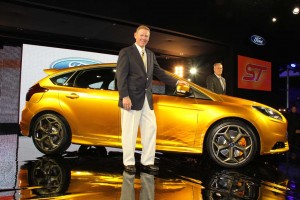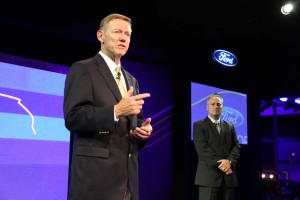While Ford Motor Co. will slash by as much as a third the number of individual nameplates it offers around the world, consumers will likely have more, rather than less products to choose from, said the maker’s CEO Alan Mulally, following the unveiling of the all-new Ford Focus at a Paris Motor Show preview.
The former Boeing executive spoke with TheDetroitBureau.com to clarify comments made during a speech in London, earlier this week, in which Mulally outlined plans to continue the ongoing cutback in Ford’s product count as it sharpens its focus on its core brands.
Since joining the company, just four years ago, Mulally has reduced the number of nameplates in the Ford stable from 97 to 37, so far largely by selling off European luxury brands Aston Martin, Jaguar, Land Rover and Volvo. But the cuts won’t stop there.
By the time this de-proliferation is completed, he noted, “there will be 25 to 30 nameplates associated with Ford covering the world.”
That figure includes Lincoln, Mulally said, though it also takes into account the elimination of the long-struggling Mercury brand. The rest of the cutback will come by actually dropping current models – which the executive declined to name.
That might seem to be running in conflict with current industry trends to add more models to fill in empty product niches. But Mulally stressed that Ford dealers won’t be stuck with empty spaces on the showroom floor. Quite the contrary. “Small, medium and large,” he insisted, Ford will be covered.
He pointed to the new Focus as an example of the revised Ford strategy. In the past, the maker developed at three very similar models for different global markets. Now, however, the same Focus will be sold around the world sharing about 80% of its content, the rest tweaked to meet individual market needs.
Now add the fact that the underlying Focus platform will “have 10 different top hats off this platform,” Mulally explained, using industry lingo to refer to distinct bodies. There will be more variations of the Focus, such as the sedan, hatchback and wagon going on display at the Paris Motor Show, as well as the performance-oriented Focus ST. There will be completely different nameplates, such as the C-Max “people-mover,” as well, a total of 2 million vehicles coming off the underlying C-segment chassis.
The critical point, the executive stressed, is that for the most part, a nameplate sold in the U.S. will likely also be available, going forward, in Europe or Latin America or Asia, under the Ford brand, replacing a proliferation of regional model names currently on sale.
The line-up won’t be absolutely identical in all markets, of course. A big pickup like the F-Series might be limited to the U.S. and a few other regions, while much of the rest of the world will get the smaller new Ranger truck. And the States might not see a European small car – or, at least for now, the Focus wagon, for that matter. But the goal is to commonize and simplify the mix worldwide.
The approach has a number of advantages, notably increasing economies of scale when components are shared – as on the Focus’s C platform on up to 2 million vehicles annually.
Meanwhile, points out Ford’s global design czar, J Mays, “We’re able to use our design talent to concentrate on getting fewer but better products.”
During a wide-ranging discussion, Ford CEO Mulally noted that the industry still has a serious issue with overcapacity in Europe, but added his belief that it is “a lot closer” to properly balancing supply with demand in the U.S., largely as a result of last year’s economic meltdown.
In some ways, the crisis triggered by that financial collapse has actually been good for Ford, Mulally said.
“I don’t think anyone would have anticipated the good will Ford has received,” he said, by not going into bankruptcy and then taking a federal bail-out.
“Everyone started looking at Ford and started seeing its strong new products,” its increasingly healthy business model and its focus on addressing environmental issues, the executive concluded. The maker’s growing sales and market share show that American buyers “want to be associated with winners.”


